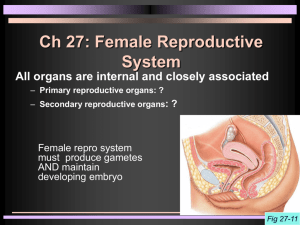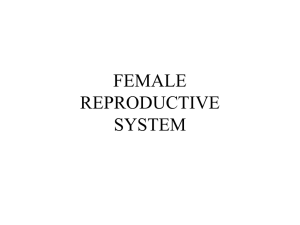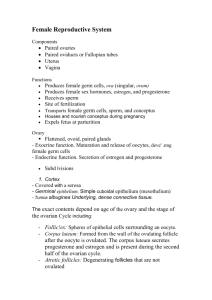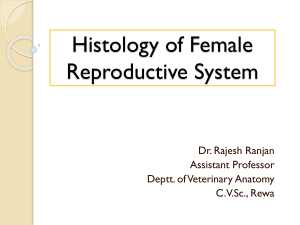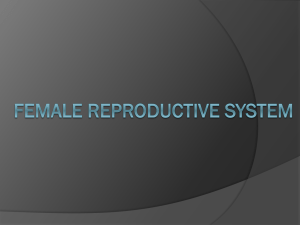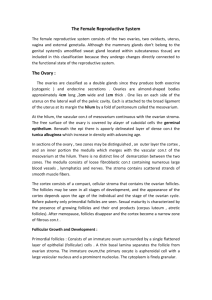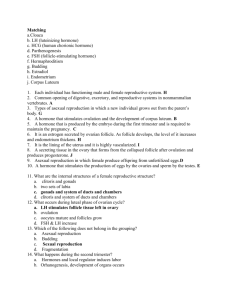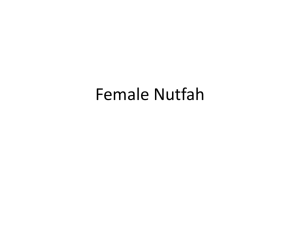Animal and Veterinary Science Department
advertisement
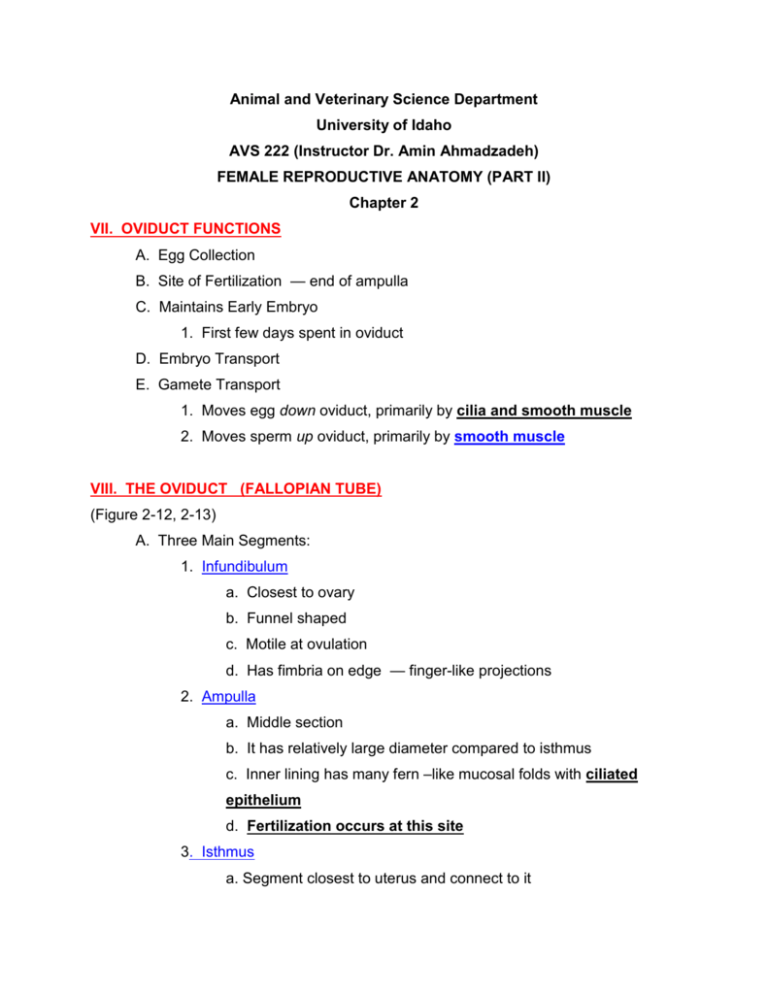
Animal and Veterinary Science Department University of Idaho AVS 222 (Instructor Dr. Amin Ahmadzadeh) FEMALE REPRODUCTIVE ANATOMY (PART II) Chapter 2 VII. OVIDUCT FUNCTIONS A. Egg Collection B. Site of Fertilization — end of ampulla C. Maintains Early Embryo 1. First few days spent in oviduct D. Embryo Transport E. Gamete Transport 1. Moves egg down oviduct, primarily by cilia and smooth muscle 2. Moves sperm up oviduct, primarily by smooth muscle VIII. THE OVIDUCT (FALLOPIAN TUBE) (Figure 2-12, 2-13) A. Three Main Segments: 1. Infundibulum a. Closest to ovary b. Funnel shaped c. Motile at ovulation d. Has fimbria on edge — finger-like projections 2. Ampulla a. Middle section b. It has relatively large diameter compared to isthmus c. Inner lining has many fern –like mucosal folds with ciliated epithelium d. Fertilization occurs at this site 3. Isthmus a. Segment closest to uterus and connect to it b. The junction to uterus is called uterotubal junction(UTJ) UTJ may regulate the movement of embryo to the uterus c. Isthmus has a ticker muscular wall compared to ampulla and has fewer mucosal folds X. OVIDUCT STRUCTURE A. Has Three Layers: 1. Tunica Serosa a. Outermost layer b. Connective tissue 2. Tunica Muscularis a. Middle layer b. Has 2 muscle layers (1) longitudinal muscle — outer layer (2) circular muscle — inner layer 3. Tunica Mucosa a. Innermost layer b. Has 2 cell types (1) ciliated cells (2) secretory cells X. THE OVARY (Figures 2-11, 2-13) A. Function 1. Produce female gametes (ova or egg) 2. Produce & release hormones Steroids hormones: estrogen and progesterone Protein hormones: oxytocin, relaxin, inhibin B. Anatomy 1. Germinal epithelium a. Outermost layer of ovary (cuboidal epithelial cells) b. Is NOT the source of ova 2. Tunica albuginea - Connective tissue layer under germinal epithelium 2. Ovarian cortex -Site of developing follicles, which contain ova (except in the mare) Houses corpus luteum (CL) 4. Medulla a. Central portion of ovary and composed of dense connective tissue b. Contains the following: 1) blood vessels 2) nerve supply 3) lymphatic system 5. Hilus -- point where nerves & blood supply enter ovary EXPETIONS (MARES)!! 6. Ovulation fossa - THE ONLY LOCATION (site) of ovulation a. In horses cortex & medulla are reversed b. Fossa provides path for ova to get through connective layer c. Follicles but not the CL can be palpated XI Ovarian Structures 1. Follicle (figure 2-11) a. Site of ova production b. Source of hormones 2. Corpus hemorrhagicum (Corpora hemorrhagica) figures 9-1A Also called developing CL a. Forms at site of ovum release b. Caused by bleeding when follicle ruptures c. Short lived (2-3 days) 3. Corpus luteum, CL (plural: Corpora lutea) figures 9-3A, 9-3B a. Literally “yellow body” b. Forms form corpus hemorrhagicum c. Secretes a lot of progesterone 4. Corpus albicans (Corpora albicantia) figure 9-4A a. Literally “white body” b. Secrets a little progesterone D. Ovarian Activity 1. In non-litter bearing animals, RIGHT ovary is more active E. All Oocytes Present at Birth 1. Human = 400,000 2. Gilt = 80,000 3. Cow = 75,000 F. In Old Cow — ovary has 2,400 oocytes 1. Most oocytes lost to atresia XII. FOLLICLES (EGG NESTS) and FOLLICULAR DEVELOPMENT (Figure 2-11) A. Primary Follicle 1. Germ cell 2. Single layer of cuboidal granulosa cells 3. Least developed follicle 4. Only follicle type present prior to puberty 5. Females are born with the life time supply of these follicles B. Secondary Follicle Develop from the primary follicle 1. Germ cell 2. At least 2 layers of granulosa cells 3. Absence of antrum (cavity) 4. Zona pellucida, a tick protein layer formed a. Acellular coat around ovum b. b. Made of 3 glycoproteins (ZP-1, ZP-2, ZP-3) C. Tertiary Follicle or Antral Follicle (Figure 2-10) 1. Germ cell 2. Many layers of granulosa cells 3. Antrum a. Fluid-filled cavity b. Liquor folliculi — high amounts of steroid hormones D. Graafian Follicle (well-developed antral follicle) 1. Follicle that will ovulate 2. Appear as blisters on ovarian surface 3. Few follicles reach this stage XIII. FOLLICULAR ANATOMY Three distinct layers of antral follicle (Figure 2-8) A. Theca Externa 1. Loose fibrous outer layer 2. Contains capillaries B. Theca Interna (Figure 8-8) 1. Under theca externa 2. Responsible for androgen (steroid) production 3. Layer contains capillaries C. Granulosa Cells (Figure 8-8) 1. Also called Stratum Granulosum 2. Located under basement membrane 3. Under influence of gonadotropin hormones produces estrogen 4. Involves with maturation of oocyte D. Zona Pellucida (Figure 12-9) 1. Non-cellular protein coat around the oocyte 2. Consists of three types of glycoproteins, ZP1, ZP2, and ZP3 E. Perivitelline Space (Figure 12-9) 1. Space between zona pellucida and cell membrane of egg F. Vitelline Membrane (Figure 12-9) 1. Cell membrane of egg G. Oocyte (Figure 12-9) 1. The germ cell 2. Contains genetic material in germinal vesicle H. Antrum 1. Fluid-filled space surrounding oocyte I. Cumulus Mass 1. Clump of oocytes held together by cumulus cells — in litter-bearing animals 2. Cumulus cells lost in oviduct **After ovulation, theca and remaining granulosa cells undergo lutenization to form the corpus luteum**



